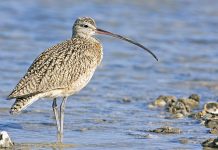The size of the ladder-backed woodpecker (Picoides scalaris) is about 17–18 cm in length. The diet of ladder-backed woodpeckers consists of foraging insects and cactus fruits. The bird forages by gleaning rather than excavating, in trees, bushes, cacti, mesquite, yuccas, and agave on the ground.
The barred black and white woodpecker (ladder-backed) wings are also barred, along with buff or white below, and the breasts are weakly spotted. The flanks are barred or streaked black, and the upper tail is black, with bold white barring on the outer three feather pairs. White or buff face crossed by black post-ocular and malar stripes that meet over the ear-coverts and lores are dusky. The bill is black, and Iris is chestnut with grey legs.
Both sexes are different, but the male has a red crown, flecked with black and white. However, the female bird is black with white spotting. Juveniles are barred and flecked brown below, both sexes, with red mid-crown, redder in males.
Related Reading: The Facts of Powerful Woodpecker

The call of a ladder-backed woodpecker is a rattling series of 14–25 notes, ending with a drop-in pitch and grating sound: kweeek-weeekweeekweeekweeechrchr, and a louder, slower kweeek-kweeek-kweekvariant. Falling, whinnying, jeee-jeee-jeee. The alarm call is sharp peek, pwik, pik or chik contact. Also, the drumming call is a rapid 1-second roll that slows and falls in pitch. Each roll has around 27–30 strikes.
ladder-backed woodpecker is often common, and considered stable, though local declines noted, e.g. Edwards Plateau, Texas. ladder-backed woodpecker habitats are desert and dry country with thorn scrub, agave, cacti, yucca, Joshua trees, and mesquite brush. Also open piñon-juniper, willow, cottonwood, pine, oak, and riparian woodlands, mangroves, and around settlements.
The range of ladder-backed woodpeckers in North and Central America, from SW USA to NE Nicaragua,. Resident, sedentary but some dispersal sea-level up to 3000 meters. There are 9 races: scalaris (S Mexico: Veracruz and Chiapas); cactophilus (SW USA, NE Baja California and C Mexico) is large, with solid black malar, broad white bars above, white below dotted black; eremicus (N Baja California) is even larger, darker, dirtier overall, white barring finer, bill and tail long.
Lucasanus (S Baja California) is small, clean, barring above whiter; sinaloensis (coastal W Mexico) is dark on face, buff and heavily streaked below; soulei (Cerralvo Island, Mexico) is also small; graysoni (Tres Marias Islands, Mexico) is buff below, finely streaked; parvus (N Yucatan, Cozumel, and Holbox Islands) is also small, short-billed, blacker on back, belly barred, forehead black; leucoptilurus (Belize, Guatemala, El Salvador, Honduras, and NE Nicaragua) is smallest race, dusky or buffy below with fewest markings.
Similar species are most like Nuttall’s Woodpecker but more finely and evenly barred above, barred on the mantle, and more buff below, with finer markings and broader white stripes on the face and neck. Male Nuttall’s red only on hind-crown and nape. The calls are also similar, although Nuttall’s rattle rises at the end. The rattling calls are maybe most like that of Arizona Woodpecker.
Related Reading – Acorn Woodpecker – A Social and Active Bird







